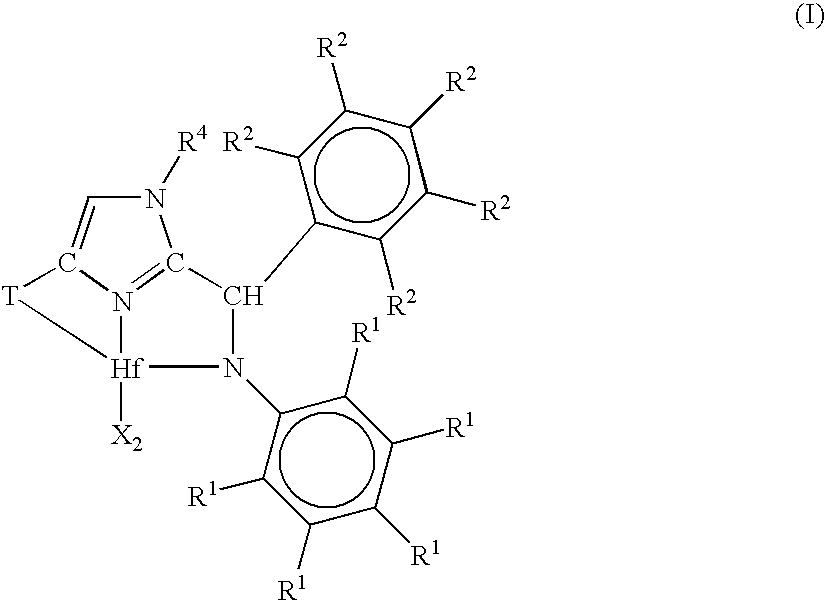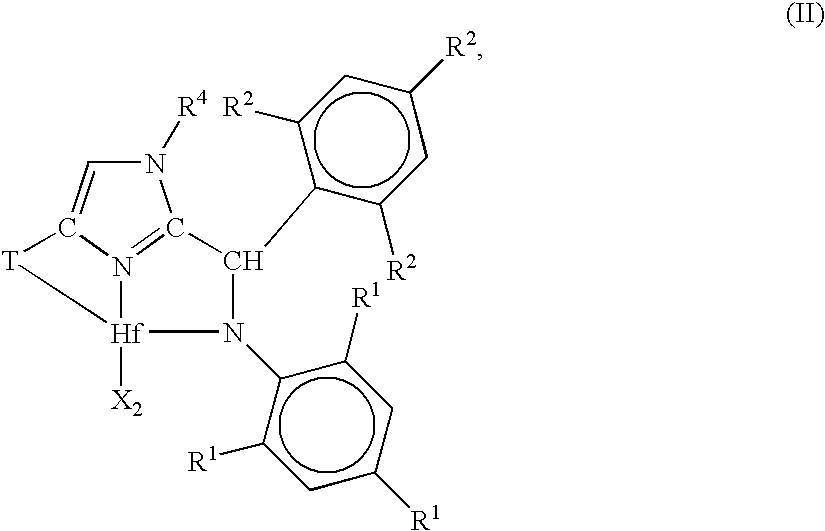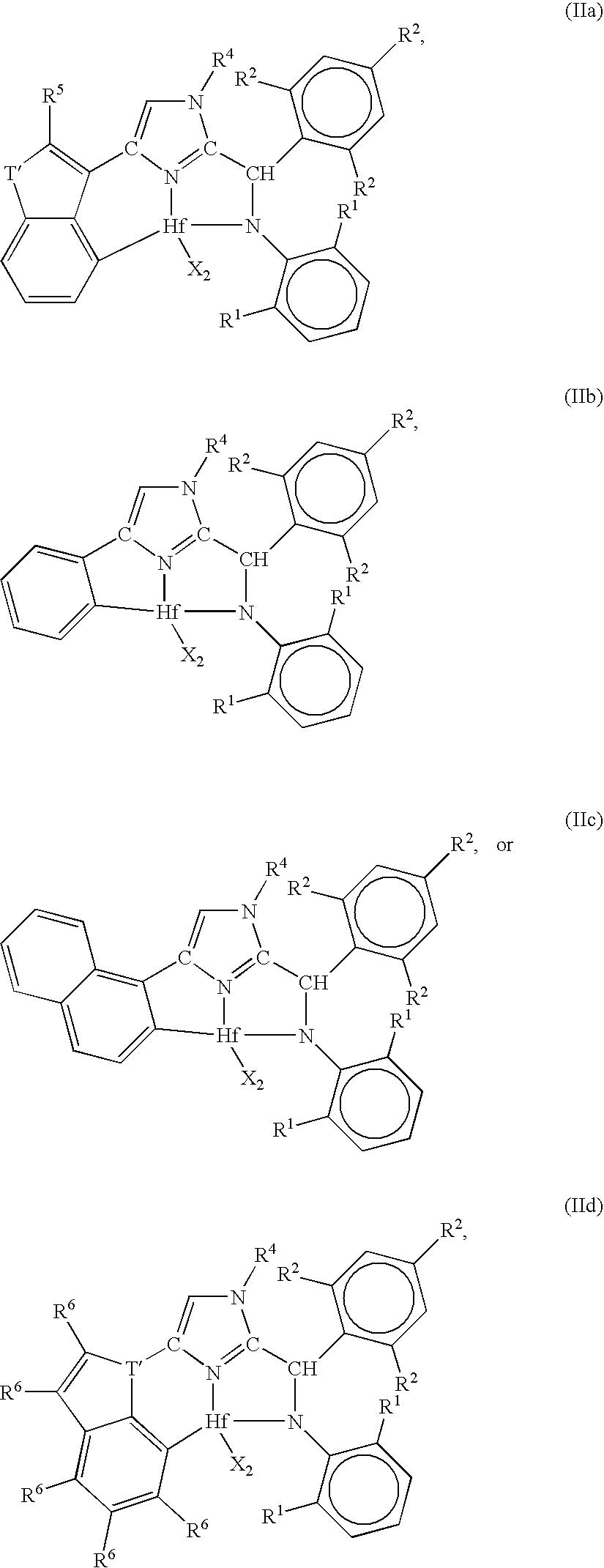Ortho-metallated hafnium complexes of imidazole ligands
a technology of orthometallated hafnium complexes and imidazole ligands, which is applied in the direction of catalyst activation/preparation, organic compound/hydride/coordination complex catalysts, physical/chemical process catalysts, etc., can solve the problems of new challenges associated with process operability, and achieve high catalyst efficiency, high molecular weight, and high molecular weight
- Summary
- Abstract
- Description
- Claims
- Application Information
AI Technical Summary
Benefits of technology
Problems solved by technology
Method used
Image
Examples
specific embodiments
[0183]The following specific embodiments of the invention and combinations thereof are especially desirable and hereby delineated in order to provide detailed disclosure for the appended claims.
[0184]1. A metal complex corresponding to the formula:
[0185]wherein, X independently each occurrence is an anionic ligand, or two X groups together form a dianionic ligand group or a neutral diene, preferably X each occurrence is a C1-20 hydrocarbyl, trihydrocarbylsilyl or trihydrocarbylsilylhydrocarbyl group;
[0186]T is a cycloaliphatic or aromatic group containing one or more rings;
[0187]R1 independently each occurrence is hydrogen, halogen, or a univalent, polyatomic anionic ligand, or two or more R1 groups are joined together thereby forming a polyvalent fused ring system;
[0188]R2 independently each occurrence is hydrogen, halogen, or a univalent, polyatomic anionic ligand, or two or more R2 groups are joined together thereby forming a polyvalent fused ring system; and
[0189]R4 is hydrogen,...
example 1
Hafnium, [N-[2,6-bis(1-methylethyl)phenyl]-α-[2,4,6-tri(1-methylethyl)phenyl]-5-(2-ethylbenzofuran-3,4-diyl-κ-C4)-2-(N′-methyl)imidazol-2-yl)methanaminato (2-)κN1,κN2]di(methyl)
[0233]
[0234](a) To a 250 mL flask equipped with magnetic stirring is added 100 mL of diethyl ether and 2-ethylbenzofuran (20.0 g, 137 mmol). The reaction flask is then cooled to 0° C. Bromine (8.40 mL, 164 mmol) is then added to an addition funnel containing 50 mL of ethyl acetate. The mixture is added dropwise to the reactor while maintaining the 0° C. temperature. The addition funnel is rinsed with an additional 20 mL of ethyl acetate. The resulting mixture is stirred for 2 hours and the temperature maintained at 0° C. The reaction is quenched with 50 mL of water. The contents of the reactor are then transferred to a 1 L separatory funnel and rinsed with 2×50 mL of water. The organic layers are combined and rinsed with 200 mL of a saturated sodium thiosulfate solution. The layers are separated and the organ...
example 2
Hafnium, [N-[2,6-bis(1-methylethyl)phenyl]-α-[2,4,6-tri(1-methylethyl)phenyl]-5-(2-ethylbenzofuran-3,4-diyl-κ-C4)-2-(N′-methyl)imidazol-2-yl)methanaminato (2-)-κN1,κN2]di(n-butyl)
[0248]
[0249](a) 2-(1)N-methyl imidazolemethanamine, N-[2,6-bis(1-isopropyl)phenyl]-α-[2,4,6-(trisopropyl)phenyl]4-3(2-ethylbenzofuran) (Ex. 1(f), 0.81 mmol dissolved in 20 mL toluene) is charged to a glass flask. To this solution is added 0.81 mmol of n-BuLi (2.5 M solution in hexanes) by syringe. This solution is stirred for 30 minutes and the toluene removed using a vacuum system attached to the drybox. Hexane is added and removed by vacuum, added again, and the resulting slurry filtered to give the lithium salt as a white solid (0.20 g, 0.32 mmol; 40 percent). A glass jar is then charged with the white solid dissolved in 30 n of toluene. To this solution is added 0.32 mmol of solid HfCl4. The flask is capped with an air-cooled reflux condenser and the mixture heated at reflux for about 4 hours. After coo...
PUM
| Property | Measurement | Unit |
|---|---|---|
| temperatures | aaaaa | aaaaa |
| Tm | aaaaa | aaaaa |
| physical | aaaaa | aaaaa |
Abstract
Description
Claims
Application Information
 Login to View More
Login to View More - R&D
- Intellectual Property
- Life Sciences
- Materials
- Tech Scout
- Unparalleled Data Quality
- Higher Quality Content
- 60% Fewer Hallucinations
Browse by: Latest US Patents, China's latest patents, Technical Efficacy Thesaurus, Application Domain, Technology Topic, Popular Technical Reports.
© 2025 PatSnap. All rights reserved.Legal|Privacy policy|Modern Slavery Act Transparency Statement|Sitemap|About US| Contact US: help@patsnap.com



